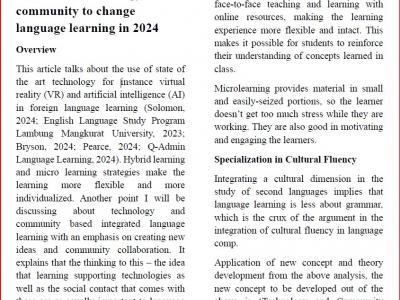Education and Learning Technologies

The term “graphical password” refers to a user authentication method where pictorial information is used for validation, instead of an alphanumerical password. This method poses many challenges, such as memo ability (which refers to how easy the password is to remember), usability, and security, since graphical passwords may tend to be visually simple and easily forged. Graphical passwords have become popular due to the proliferation of touch screen devices, in particular smart phones and tablets.
- Categories:
 58 Views
58 Views
A green screen is a backdrop against which footage is shot to later be
superimposed over a separately-filmed background in a visual effects process
called “chroma keying.” It is also known as chroma key compositing, colorkeying,
or simply keying..
This term describes removing the green screen background in post-production using
video editing software. When the green screen background has been keyed, it'll be
fully transparent..
- Categories:
 32 Views
32 Views
A musical instrument store is a web based application where users can view various musical
instruments along with their description. The project provides user with a flexible and attractive
GUI and shows him a list of products and carry out all the shopping activities online.
This project is developed for users to have a brief look at the instruments without actually visiting
the store. The website displays different kinds of instruments of different brands so that user can
easily get their expected instrument.
- Categories:
 45 Views
45 Views
As the name specifies “HOSTEL MANAGEMENT SYSTEM” is a software
developed for managing various activities in the hostel. For the past few years the
number of educational institutions are increasing rapidly. Thereby the number of hostels
are also increasing for the accommodation of the students studying in this institution.
And hence there is a lot of strain on the person who are running the hostel and software’s
are not usually used in this context. This particular project deals with the problems on
- Categories:
 103 Views
103 Views
The data provided the raw coding data for systematic review and meta-analysis of AR in higher education. Regarding the coding data for systematic review, the coding scheme comprises five parts: basic information, disciplines, technology features, instructional design, and research results. Regarding the coding data for meta-analysis, we code the effect size and several moderating variables of the selected experimental research studies.
- Categories:
 69 Views
69 ViewsThe Theory of Integrated Language Learning (ToILL) supports many complementary schools of educational thought. The constructivism, pragmatism, humanism, and sociocultural theory are combined in one process to produce an integrated and successful method of language acquisition. The approach promotes the complete person development in a continuously changing environment that is global in nature but does not stop at cognitive components but also concerns the social and emotional experiences of the students.
- Categories:
 263 Views
263 ViewsA number of major aspects of creative English language teaching are reviewed in this. What makes this research interesting is the integration of technology, mostly via artificial intelligence (AI) and mobile based learning, which give new ways to improve the student engagement and learning results.
- Categories:
 133 Views
133 Views
Here i got parsed literature site https://avidreaders.ru for about 10.000.000 sentences from russian books and make sentence vector embeddings from them using Mistral open API.
Embeddings got resized from 1024 to 256 dimensions using python scikit-learn PCA method.
Word embeddings are a way of representing words as vectors in a multi-dimensional space, where the distance and direction between vectors reflect the similarity and relationships among the corresponding words.
- Categories:
 68 Views
68 ViewsThe Reflectance Transformation Imaging dataset consists of 32 images from the squeeze of the inscription "Hymn of Kouretes" or "Hymn of Palaikastron" (fragment A, side A) which is hosted at the Archaeological Museum of Heracleon, Crete. The resulting .PTM file is also available, which opens with the free software RTI Viewer.
- Categories:
 254 Views
254 ViewsWe develope a novel TCM hallucination detection dataset, Hallu-TCM, sine no prior work has attempted this task in TM. We selected 1,260 TCM exam questions including 16 TCM subjects, input them into GPT-4, and collected their feedback. In the first level, we utilize Qwen-Max interface to annotate feedback multiple times with the binary label. If Qwen-Max consistently provided the same label across annotations, we adopted that label. For contentious cases, we recruited higher-degree research students who can understand and solve complex questions, including three Ph.D.
- Categories:
 187 Views
187 Views


